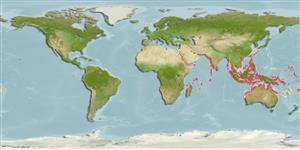Teleostei (teleosts) >
Eupercaria/misc (Various families in series Eupercaria) >
Scaridae (Parrotfishes) > Scarinae
Etymology: Scarus: Greek, skaros = a fish described by anciente writers as a parrot fish; 1601 (Ref. 45335).
More on author: Smith.
Environment: milieu / climate zone / depth range / distribution range
Ecology
Marine; reef-associated; non-migratory; depth range 1 - 15 m (Ref. 90102). Tropical
Western Indian Ocean: East Africa, including Madagascar, Seychelles, and Maldives. Also reported from Phuket, Thailand and Bali and Sulawesi, Indonesia (Ref. 9232). Probably related to Scarus spinus in the Central and Western Pacific.
Size / Weight / Age
Maturity: Lm ? range ? - ? cm
Max length : 45.0 cm TL male/unsexed; (Ref. 48636); max. published weight: 600.00 g (Ref. 3488)
Males recognized by the nearly all green snout from front of eyes (Ref. 48636). 4 median predorsal scales; 2 scales on third row on the cheek; ii 12 pectoral fin rays; 1 main and 2 rudimentary rows of teeth on the upper pharyngeal which are deep interdigitated, with main teeth notched-shaped; length/width ratio of the lower dental plate is 2.80 (Ref. 37269).
Found solitary (Ref. 90102) in shallow reefs, on flats and reef fronts or rocky shores of high islands (Ref. 9710); also on mixed algae rubble and rich coral patches (Ref. 48636). Feeds on benthic algae (Ref. 30573). Caught with nets and other kinds of artisanal gear. Sold mostly fresh in markets (Ref. 3488). Close relative of S. spinus of the Pacific but has allopatric distribution (except Bali) (Ref. 90102).
Life cycle and mating behavior
Maturity | Reproduction | Spawning | Eggs | Fecundity | Larvae
Oviparous, distinct pairing during breeding (Ref. 205).
Bruce, R.W. and J.E. Randall, 1984. Scaridae. In W. Fischer and G. Bianchi (eds.) FAO species identification sheets for fishery purposes. (Western Indian Ocean fishing area 51). volume 3. [var. pag.] FAO, Rome. (Ref. 3488)
IUCN Red List Status (Ref. 130435: Version 2024-1)
Threat to humans
Harmless
Human uses
Fisheries: commercial
Tools
Special reports
Download XML
Internet sources
Estimates based on models
Preferred temperature (Ref.
123201): 26.4 - 29.3, mean 28.6 °C (based on 2913 cells).
Phylogenetic diversity index (Ref.
82804): PD
50 = 0.5000 [Uniqueness, from 0.5 = low to 2.0 = high].
Bayesian length-weight: a=0.01445 (0.00674 - 0.03099), b=3.03 (2.86 - 3.20), in cm total length, based on LWR estimates for this Genus-body shape (Ref.
93245).
Trophic level (Ref.
69278): 2.0 ±0.00 se; based on food items.
Resilience (Ref.
120179): Medium, minimum population doubling time 1.4 - 4.4 years (Preliminary K or Fecundity.).
Fishing Vulnerability (Ref.
59153): Low to moderate vulnerability (35 of 100).
Nutrients (Ref.
124155): Calcium = 38.6 [25.1, 62.7] mg/100g; Iron = 0.738 [0.512, 1.132] mg/100g; Protein = 18.7 [16.6, 20.5] %; Omega3 = 0.0817 [, ] g/100g; Selenium = 17 [11, 27] μg/100g; VitaminA = 46.9 [14.2, 154.4] μg/100g; Zinc = 2.18 [1.65, 2.84] mg/100g (wet weight);
